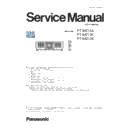Panasonic PT-MZ16K / PT-MZ13K / PT-MZ10K (serv.man2) Service Manual ▷ View online
4
PREFACE
<MZ16K/MZ13K/MZ10K>
r
Projection in all 360° direction is possible.
360°
360°
360°
360° vertically
360° horizontally
360° tilted
(Combination of vertical and horizontal)
r
Cautions when setting up the projector
f
Use the adjustable feet only for the floor standing installation and for adjusting the angle. Using them for other purposes
may damage the projector.
f
Do not stack projectors on top of each other.
f
Do not use the projector supporting it by the top.
f
Do not block the ventilation ports (intake and exhaust) of the projector.
f
Prevent hot and cool air from the air conditioning system to blow directly to the ventilation ports (intake and exhaust) of the
projector.
r
The projector may not work properly due to strong radio wave from the broadcast station or the radio.
f
If there is any facility or equipment which outputs strong radio waves near the installation location, install the projector at a
location sufficiently far from the source of the radio waves. Or, wrap the LAN cable connected to the <DIGITAL LINK/LAN>
terminal using a piece of metal foil or a metal pipe which is grounded at both ends.
r
Focus adjustment
f
The high clarity projection lens is thermally affected by the light from the light source, making the focus unstable in the pe-
riod just after switching on the power. When the [PROJECTOR SETUP] menu → [LENS] → [ACTIVE FOCUS OPTIMIZER]
is set to [OFF], it is recommended to perform the focus adjustment after 30 minutes or more have elapsed with the focus
test pattern displayed.
For details of [ACTIVE FOCUS OPTIMIZER], refer to the [PROJECTOR SETUP] menu → [LENS] → [ACTIVE FOCUS OP-
TIMIZER].
For details of the test pattern, refer to “[TEST PATTERN] menu”.
r
Do not install the projector at an altitude of 2 700 m (8 858') or higher above sea level.
r
Do not use the projector in a location that the ambient temperature exceed 45 °C (113 °F).
f
Using the projector in a location that the altitude is too high or the ambient temperature is too high may reduce the life of the
components or result in malfunctions.
5
PREFACE
<MZ16K/MZ13K/MZ10K>
CONTENTS
1. Safety Precautions
1.1. General Guidelines
1.2. Leakage Current Check
1.2. Leakage Current Check
2. Specifications
SECTION 1 SERVICE INFORMATION
1. The name of each part
1.1. Remote controls
1.2. Projector body
1.3. Control panel
1.4. Connecting terminals
1.2. Projector body
1.3. Control panel
1.4. Connecting terminals
2. Menu Navigation
2.1. On-screen
3. Service Mode
3.1. Setting to Service Mode
3.2. Resetting to User Mode
3.3. Functions of Service Mode
3.2. Resetting to User Mode
3.3. Functions of Service Mode
4. Notes on service
4.1. Before service operation
4.2. Service
4.3. Note on the parts replacement work
4.4. Replacement of consumable parts
4.5. Security password
4.2. Service
4.3. Note on the parts replacement work
4.4. Replacement of consumable parts
4.5. Security password
5. Troubleshooting
5.1. LIGHT/TEMP/FILTER indicators
5.2. Information monitor
5.3. Shutdown system
5.4. System log data acquisition method
5.5. Self-diagnosis & error code table
5.6. Self-diagnosis information acquisition by control
5.2. Information monitor
5.3. Shutdown system
5.4. System log data acquisition method
5.5. Self-diagnosis & error code table
5.6. Self-diagnosis information acquisition by control
commands
5.7. Troubleshooting
SECTION 2 DISASSEMBLY PROCEDURES
1. Parts Locations
1.1. Electrical parts location (P.C.Boards)
1.2. Electrical parts location (Fans)
1.3. Mechanical parts location
1.4. Optical parts location
1.2. Electrical parts location (Fans)
1.3. Mechanical parts location
1.4. Optical parts location
2. Mechanical and Electrical Parts Disassembly
r
Disassembly flow chart
2.1. Air filter unit, Air filter cover removal
2.2. Projection lens removal
2.3. Top cover removal
2.4. Terminal cover removal
2.2. Projection lens removal
2.3. Top cover removal
2.4. Terminal cover removal
2.5. A-PCB block removal
2.6. K-PCB block removal
2.7. Phosphor wheel block, RK-PCB removal
2.8. Front cover removal
2.9. Power block removal
2.10. Lighting case block removal
2.11. Filter case removal
2.12. Intake duct top, PBS fan removal
2.13. NF-PCB, Radiator fan block removal
2.14. LD exhaust fan removal
2.15. LD case block removal
2.16. PW fan removal
2.17. LCD fans removal
2.6. K-PCB block removal
2.7. Phosphor wheel block, RK-PCB removal
2.8. Front cover removal
2.9. Power block removal
2.10. Lighting case block removal
2.11. Filter case removal
2.12. Intake duct top, PBS fan removal
2.13. NF-PCB, Radiator fan block removal
2.14. LD exhaust fan removal
2.15. LD case block removal
2.16. PW fan removal
2.17. LCD fans removal
3. Optical Parts Disassembly
r
Disassembly flow chart
3.1. Prism cover removal
3.2. Optical block removal
3.3. Polarizer (In) removal
3.4. Lighting case top removal
3.5. PBS, Integrator lens removal
3.6. Parts location and direction in the lighting case
3.2. Optical block removal
3.3. Polarizer (In) removal
3.4. Lighting case top removal
3.5. PBS, Integrator lens removal
3.6. Parts location and direction in the lighting case
<Cable wiring>
SECTION 3 ADJUSTMENTS
1. Adjustment Items and Procedures
1.1. Polarizer adjustment
1.2. Lens calibration
1.3. Electrical convergence adjustment
1.4. Adjusted data transfer
1.5. Panel type setting
1.6. Flicker adjustment
1.7. Model setting
1.8. Ghost feedback calibration
1.9. Clog sensor calibration
1.10. LD unit runtime reset
1.11. Date and time setup
1.2. Lens calibration
1.3. Electrical convergence adjustment
1.4. Adjusted data transfer
1.5. Panel type setting
1.6. Flicker adjustment
1.7. Model setting
1.8. Ghost feedback calibration
1.9. Clog sensor calibration
1.10. LD unit runtime reset
1.11. Date and time setup
2. Firmware update procedure
6
PREFACE
<MZ16K/MZ13K/MZ10K>
1. Safety Precautions
1.1. General Guidelines
- For continued safety, no modification of any circuit must be attempted.
- Unplug the power cord from the power outlet before disassembling this projector.
- Use correctly the supplied power cord and must ground it.
- It is advisable to use an isolation transformer in the AC power line before the service.
- Be careful not to touch the rotation part (cooling fan, etc.) of this projector when you service with the upper case removed
and the power supply turned ON.
- Observe the original lead dress during the service. If a short circuit is found, replace all the parts overheated or damaged
by the short circuit.
- After the service, all the protective devices such as insulation barriers, insulation papers, shields, and isolation R-C combi-
nations must be properly installed.
- After the service, check the leakage current to prevent the customer from getting an electric shock.
1.2. Leakage Current Check
1. Prepare the measuring circuit as shown in Fig.1.
Be sure to use a voltmeter having the performance described in Table 1.
2. Assemble the circuit as shown in Fig. 2. Plug the power cord in a power outlet.
3. Connect M1 to T1 according to Fig. 2 and measure the voltage.
4. Change the connection of M1 from T1 to T2 and measure the voltage again.
5. The voltmeter must read 0.375 V or lower in both of steps 3 and 4. This means that the current must be 0.75mA or less.
6. If the reading is out of the above standard, the projector must be repaired and rechecked before returning to the customer
because of a possibility of an electric shock.
M1
M2
Rs
Cs
Rb
10KΩ ±0.1%
0.022µF
±1.0%
Vb
(V) V
Rs: 1500 Ω±0.1%
Cs: 0.22 µF±1.0%
Rb: 500 Ω±0.1%
to T1
or T2
in FIg.2
Weighted leakage current=Vb / 500 (A)
Fig. 1
Isolation transformer
T1
T2
connection
to power outlet
M1
M2
Fig.2
Projector
Measuring
Circuit (Fig.1)
Performance
Voltmeter
(rms reading)
Accurancy:
≤ 2%
Input resistance:
≥ 1 MΩ
Input capacitance: ≤ 200 pF
Frequency range: 15 Hz to 1 MHz
Table. 1
7
PREFACE
<MZ16K/MZ13K/MZ10K>
2. Specifications
Chapter 7 Appendix — Specifications
234 - ENGLISH
Specifications
The specifications of the projector are as follows.
Power supply
100 V - 240 V ~ (100 V - 240 V alternating current), 50 Hz/60 Hz
Power consumption
PT-MZ16K
1 050 W (11.0 A - 4.5 A)
PT-MZ13K
800 W (8.3 A - 3.4 A)
PT-MZ10K
640 W (6.5 A - 2.7 A)
Power consumption (during
standby)
Approx. 0.5 W
When [STANDBY MODE] is set to [ECO]
Approx. 8 W
When [STANDBY MODE] is set to [NORMAL]
Approx. 150 W
When [QUICK STARTUP] is set to [ON] and the power is supplied from the <DC
OUT> terminal
LCD panel
Size
25.4 mm (1.0") (aspect ratio 16:10)
Display system
Translucent screen LCD panel 3 panels, 3 primary colors system
Drive system
Active matrix
Number of pixels 2 304 000 pixels (1 920 x 1 200 dots) x 3
Lens
Optional
Light source
Laser diode
Light output
PT-MZ16K
16 000 lm
*1
(when [OPERATING MODE] in [OPERATION SETTING] is set to [NORMAL])
PT-MZ13K
13 000 lm
*1
(when [OPERATING MODE] in [OPERATION SETTING] is set to [NORMAL])
PT-MZ10K
10 000 lm
*1
(when [OPERATING MODE] in [OPERATION SETTING] is set to [NORMAL])
Center to corner zone ratio
*1
90 %
Contrast ratio
*1
3 000 000:1 (when [DYNAMIC CONTRAST] is set to [3])
Projected image size
2.03 m (80") to 12.70 m (500")
Image aspect ratio
16:10
Projection method
[FRONT]/[FLOOR], [FRONT]/[CEILING], [REAR]/[FLOOR], [REAR]/[CEILING]
Power cord length
3.0 m (118-1/8")
Outer case
Molded plastic
Outer color
Black model
Black
White model
White
Dimensions
Width
650 mm (25-19/32")
Height
185 mm (7-9/32") (with the feet at shortest position)
Depth
440 mm (17-5/16") (excluding the optional lens)
Weight
Approx. 22.3 k] (49.1 lbs.)
*2
(excluding the optional lens)
Noise level
*1
PT-MZ16K
38 dB
(when [OPERATING MODE] in [OPERATION SETTING] is set to [NORMAL])
PT-MZ13K,
PT-MZ10K
35 dB
(when [OPERATING MODE] in [OPERATION SETTING] is set to [NORMAL])
Laser
Classification
Laser Class
USA and Canada: Class 3R (IEC 60825-1:2007)
Other countries or regions: Class 1 (IEC/EN 60825-1:2014)
Other countries or regions: Class 1 (IEC/EN 60825-1:2014)
Risk Group
PT-MZ16K
ET-EMW200, ET-EMW300,
ET-EMW400, ET-EMW500,
ET-EMS600
Risk group 2 (IEC 62471-5:2015)
ET-EMT700
*3
Risk group 2 or Risk group 3 (IEC
62471-5:2015)
ET-EMT800
Risk group 3 (IEC 62471-5:2015)
PT-MZ13K
ET-EMW200, ET-EMW300,
ET-EMW400, ET-EMW500,
ET-EMS600
Risk group 2 (IEC 62471-5:2015)
ET-EMT700
*4
Risk group 2 or Risk group 3 (IEC
62471-5:2015)
ET-EMT800
Risk group 3 (IEC 62471-5:2015)
PT-MZ10K
ET-EMW200, ET-EMW300,
ET-EMW400, ET-EMW500,
ET-EMS600, ET-EMT700
Risk group 2 (IEC 62471-5:2015)
ET-EMT800
*5
Risk group 2 or Risk group 3 (IEC
62471-5:2015)


